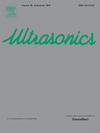由声发射地震矩张量推断的砂岩裂缝带各向异性。
IF 4.1
2区 物理与天体物理
Q1 ACOUSTICS
引用次数: 0
摘要
我们提出了一种岩石弹性各向异性参数的反演方法,该方法使用了来自声发射(ae)的大量精确矩张量(MTs)。这种方法是用在半圆弯曲试验中观察到的砂岩样品的ae来证明的。我们反演了539个高精度ae的MTs,并检索了各向异性轴的方向和弹性参数,这些参数定义了试样在测试过程中形成的裂缝区内的正交各向异性。各向异性的产生是由于断裂带中排列裂缝的存在和砂岩试样的背景横向各向同性。观测到的各向异性适中,P波、S1波和S2波的强度分别为18%、14%和21%。我们发现,忽略这种各向异性会在从MTs估计裂缝方向和张力时引入明显的偏差。当通过将矩张量重新计算为源张量来考虑各向异性效应时,裂缝方向上的散射会减少,并且表征裂缝张力的斜率会系统地增加约10°。我们的结果证实,所提出的反演方法是一个强大的和稳健的工具,能够分析岩石的各向异性,即使在低各向异性对称性的情况下。本文章由计算机程序翻译,如有差异,请以英文原文为准。
Anisotropic properties of fracture zone in sandstone inferred from seismic moment tensors of acoustic emissions
We present an inversion for elastic anisotropy parameters of rocks using a large set of accurate moment tensors (MTs) derived from acoustic emissions (AEs). This method is demonstrated using AEs observed in a sandstone sample during a semi-circular bend test. We inverted 539 highly accurate MTs of AEs and retrieved both the orientation of anisotropy axes and elastic parameters defining the orthorhombic anisotropy within the fracture zone that developed in the sample during the test. The anisotropy results from the presence of aligned cracks in the fracture zone and the background transverse isotropy of the sandstone specimen. The observed anisotropy is moderate, with strengths of 18%, 14% and 21% for the P, S1 and S2 waves, respectively. We show that neglecting this anisotropy introduces a significant bias when estimating crack orientation and tensility from MTs. When anisotropy effects are accounted for by recalculating moment tensors into source tensors, the scatter in crack orientations is reduced, and the slope angle, which characterizes crack tensility, is systematically increased by approximately 10°. Our results confirm that the presented inversion method is a powerful and robust tool, capable of analyzing anisotropy in rocks, even in cases of low anisotropy symmetry.
求助全文
通过发布文献求助,成功后即可免费获取论文全文。
去求助
来源期刊

Ultrasonics
医学-核医学
CiteScore
7.60
自引率
19.00%
发文量
186
审稿时长
3.9 months
期刊介绍:
Ultrasonics is the only internationally established journal which covers the entire field of ultrasound research and technology and all its many applications. Ultrasonics contains a variety of sections to keep readers fully informed and up-to-date on the whole spectrum of research and development throughout the world. Ultrasonics publishes papers of exceptional quality and of relevance to both academia and industry. Manuscripts in which ultrasonics is a central issue and not simply an incidental tool or minor issue, are welcomed.
As well as top quality original research papers and review articles by world renowned experts, Ultrasonics also regularly features short communications, a calendar of forthcoming events and special issues dedicated to topical subjects.
 求助内容:
求助内容: 应助结果提醒方式:
应助结果提醒方式:


